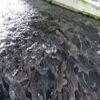In contrast to macronutrients, micronutrient elements are required by plants in small quantities. Micronutrients in general have several characteristics in common and their behaviors, both in soils and plants, take similar patterns though each has a distinct effect on the performance of crops. The following are the forms and functions of micronutrients;
1. Iron, Fe
The concentration of iron in plant tissue is between 5-200ug g-1 (ppm). Iron is taken up by plants in its ferric (Fe3+) or ferrous (Fe2+) forms as well as soluble chelates, considering the massive amounts of irons (4-5% of soil) in the soil, the small tissue content implies that most iron in the soil, is not available to plants or that plants have selective uptake for iron.
Functions
Iron is mainly involved in oxidation-reduction reactions being a constituent of ferredoxin, the electron carrier in the cytochrome system. It, therefore, participates in NO- and SO 2 reduction, N-fixation, and the activation of enzymes of the electron transfer chain.
Iron is important for the formation of chlorophyll. Iron is a constituent of hemoprotein in the root modules of leguminous plants. Iron and manganese may have to be present together for the functioning of certain coenzymes.
Deficiency Symptoms
Since its deficiency leads to failure of chlorophyll synthesis, the same “chlorosis” is used to describe Fe – deficiency symptoms. A deficiency of iron causes chlorosis (whitening) of new leaves since it is immobile.
The whitening is bleached condition is preceded by interveinal chlorosis, especially in citrus. Iron deficiency is cured by foliar spraying ferrous sulphate (FeSo4) 0.5% solution.
2. Manganese, Mn
Manganese is taken up by plants as the manganous ion Mn2+ and Mn– chelate through the leaves as it is usually applied as a foliar spray to correct the deficiency.
Plant Mn ranges between 5-100ug g–1 but may be higher in arable crops (15-300ug g–), some crops have a high tolerance for Mn such as citrus, rice, pineapple, and coniferous trees. Plants with less than 10ug g–1 Mn tend to be deficient.
Functions
Manganese functions in plants in the following ways:
Activation of enzyme systems especially in carbohydrate metabolism, citric acid cycle, and phosphorylation reactions where Mn is a co-factor for various enzymes.
Mn is required in the splitting of the water molecules, and H2O in photosynthesis whereby leading to the formation of oxygen, O2.
Mn is also involved in the assimilation of CO2 during photosynthesis.
Manganese participates in oxidation-reduction reactions. Mn is required in the reduction of nitrate since the enzyme nitrate reductase requires Mn to function.
Mn is involved in the formation of riboflavin, ascorbic acid, and carotene.
In general, Mn deficiency has been found to be prevalent in sands, organic soils, high pH calcareous soils, and soils used for the continuous cultivation of fruits and vegetables. Mn toxicity occurs in acid soils which could be ameliorated by liming.
Manganese deficiency is common in Scotland because of its high pH and high organic matter.
In soil with high organic matter, Mn deficiency is easily induced by raising pH to 6.5 – 7.0. Advisory services in Schotland, therefore, recommends liming up to pH6.2 whereas, in England and Wales, it is pH6.5.
Read Also: Analytical Methods for Available Potassium, Magnesium, and Calcium
3. Cooper, Cu
Cooper is taken up by plants as the cupric (Cu2+) and less as cuprous (Cu+) ions. Like iron and manganese, the normal Cu level in plants is also 10ug g-1 with a range of 1 to 75ug g-1. The deficiency level in plants is less than 3.0ug g-1.
Functions
In plants, Cu serves as an enzyme activator as it is associated with oxidation-reduction system oxidases found active during the last stage of the cytochrome system of respiration and in photosynthesis by activating ribulose diphosphate carboxylase.
Deficiency of Cu
There is always a problem in estimating deficiency levels due to low values. As an immobile element, symptoms of Copper deficiency are seen in growing points and deficiency generally leads to the death of plant parts.
There is a die-back of terminal growing points. The auxiliary buds will develop into a “bushy” growth part of the plant. There may be some dead spots, yellowing of younger leaves, and leaf curls.
In maize, Copper deficiency leads to the accumulation of iron because iron is not utilized in the plant when Copper is deficient. There may be a twist on the needle of trees which itself may take an unusual shape. In effect, tree form may be affected. In effect.
Toxicity of Cu: May occur in fields sprayed with Cu- containing pesticides such as Bordeaux mixture which is an insecticide containing CuSO4 + Ca (OH)2. Correcting Cu deficiency is done by spraying with CuSO4 (0.1% solution) or with copper oxychloride (0.1%).
4. Zinc, Zn
Zinc is absorbed by plants as the divalent cation, Zn2+ only since it is not affected by oxidation-reduction reaction in the soil-plant system.
Functions
The growth regulator, indoleacetic acid (IAA), produced in the absence of Zn; is reduced.
Similarly, the zinc enzyme is involved in auxin production which encourages stem elongation. Zinc is associated with the enzyme which participates in carbonic anhydrase and several dehydrogenases of respiration and nitrogen metabolism.
Deficiency Symptoms
Zinc deficiency leads to low production of auxin which in turn results in shortened internodes and bushy leaves at the end of branches often referred to as rosette type of growth.
Leaves become small stiff and brittle and fall prematurely. Zinc is slightly mobile in plants. The deficiency symptom (interveinal chlorosis) appears on both younger and older leaves.
Zinc deficiency is corrected by using small amounts of Zn chelates or Zn SO4 as foliar sprays especially on trees and ornamentals at rates of 0.5 – 2kg Zn ha-1 for foliar sprays and 10-20kg Zn ha-1 for soil amendments. Crops most susceptible to zinc deficiency are beans, citrus, corn, grapes, onion, rice, and soya bean.
Soil Zinc
Zinc is similar to copper in its chemistry. Zinc appears as a positive ion, Zn2+, which is immobile in soil. It is less soluble in anaerobic than aerobic soil in contrast to iron and manganese.
Other forms of Zn in soils are Zn (OH)+ at pH7-8 and Zn (OH)2 precipitate at pH 9.0. It could also form Zn S in paddy soils where sulphides are produced from decomposing organic matter under anaerobic conditions.
5. Boron, B
Boron is required in small amounts similar to manganese but with wide differences among plants. The amount in tissue is about 2-75ug g-1. Boron is taken up as boric acid, H3 BO3, or as simple organic compounds. Boron does not form chelates but complexes.
Functions of Boron
Boron is possibly involved in cell wall formation in the meristematic tissues of plants alongside calcium.
Boron is involved in carbohydrate metabolism. Low boron level leads to accumulation of carbohydrates in the leaves and low carbohydrates in the roots and meristematic tissues. This is because the sugars and starch manufactured in the leaves are not transported to roots in the absence of boron.
Boron affects flowering, fruiting, and pollen germination.
Boron is required for cell division, N-metabolism, active salt absorption, hormone movement, and water metabolism.
Crops with high boron requirements are tomatoes, sunflower, cabbage family, sugar beet, and alfalfa, while maize, cowpea, soya bean, and most grasses have low boron requirements.
Boron Deficiency Symptoms
Boron deficiency may easily result from excessive leaching in sandy soils and high rainfall areas. It is not easily mobile in plants, therefore, boron deficiency affects, first, the growing points.
Cell walls fail to develop at growing points. There are thin cell-walled cells of growing tissues thus giving opportunity for secondary infection such as heat rot of sugar beet, whereby growing points rot and turn black and the plant may die off.
Names are used for B-deficiency e.g. canker of beets, the hollow stem of cauliflower, the cracked stem of celery, water core of rutabagas, and stem- and russet of tomatoes.
There may be shortening of internode leading to a boundary appearance like bunch top virus disease. In the Western States of Nigeria, boron deficiency has been observed in oil palm and cocoa plants.
The range between deficiency and toxicity of boron is small. Toxicity may occur in acid soils where boron accumulates and also in irrigated water if it is above 1.0ug g-1.
In most boron amendments, borax fertilizer (sodium tetraborate Na2 B4 O7 .5H2O), which is about 14 percent boron, is used. In Britain, sodium borate is mixed with other fertilizers and it is called boronated fertilizer. So labor Na2 B8 O13. 4H2O is about 20% boron and completely water soluble; it is used as liquid fertilizer or as powder spray.
6. Molybdenum, Mo
Molybdenum (Mo) is most difficult to work with because it is present in the soil in minute quantities. It is absorbed by plants as moderate ion MoO4-2 in the soil solution. Deficiency symptoms in plants begin to set in at concentrations less than 2.0ug g-1.
Molybdenum is usually deficient in acid soils while other micronutrients are usually deficient in alkaline soils. Soils high in metal oxides (sesquioxides) have low molybdenum availability.
Functions of Molybdenum in Plants
Molybdenum’s main function is its association with nitrate-reductase, usually with manganese, for the assimilatory reduction of nitrates NO3 in plants.
Molybdenum is also associated with enzyme nitrogenase in root nodules of legumes for nitrogen fixation. If NH4 + is applied to crops, then Mo may not be needed.
Mo Deficiency
There is a malformation of the plant referred to as the “whiptail” of cauliflower, whereby the leaves are thin, brittle, and stunted. There is also a “yellow leaf sport” of cashew associated with Mo deficiencies. Usually, Mo affects the form and growth of leaves.
Deficiency is cured by spraying with sodium molybdate Na2 Mo O4.2H2O which is about 40 percent Mo at a rate of only 40 – 400 grams per hectare (0.04 – 0.4kg). Ammonium molybdate NH4)6 Mo7 O24 .2H2O is also an effective fertilizer to correct Mo deficiency.
Importance of Molybdenum to Animals
Molybdenum is in association with Mo – Cu – S compounds in animals. The three elements have to occur in appropriate balance in plants on which the animals feed. Toxic concentrations of molybdenum in soils affect grazing animals more than plants. Alkaline soils are high in organic matter.
Mo can become toxic causing an imbalance between copper and molybdenum. Animal feeding on grasses grown on such soils has stunted growth and bone deformation called molybdenosis or heart pasture disease. Animals could be treated with a dose of CuSO4 or copper fertilizer could be added to the grazing area.
7. Chloride, Cl
Chlorine is present in all soils in adequate amounts. It is absorbed as the chloride ion, Cl. Plants responding to chlorine deficiency include tobacco, tomatoes, maize, and cotton. To prove that chlorine is an essential element, boyer et. al 1954 performed experiments to show that chlorine essential element.
The amount required by the plant is not well known but the amount present in plant tissue is about 100 to 500ug g-1 (as for Fe and Mn).
Functions of Chlorine in Plants
The exact functions of chlorine are not yet well documented but it is found as an inorganic ion in the cell sap. In plants, chlorine participates in osmosis and in balancing cell cationic charges.
It is a universal contaminant because it comes from ocean water. Chlorine deficiency makes plants wilt, plants become chlorotic and necrotic in some areas, and may exhibit “leaf bronzing.”
With excess chlorine, the leaves of tobacco and potatoes become thickened and tend to roll. Storage quality of potato tubers and smoking quality of tobacco are lowered.
Read Also: General Characteristics of Micronutrients





